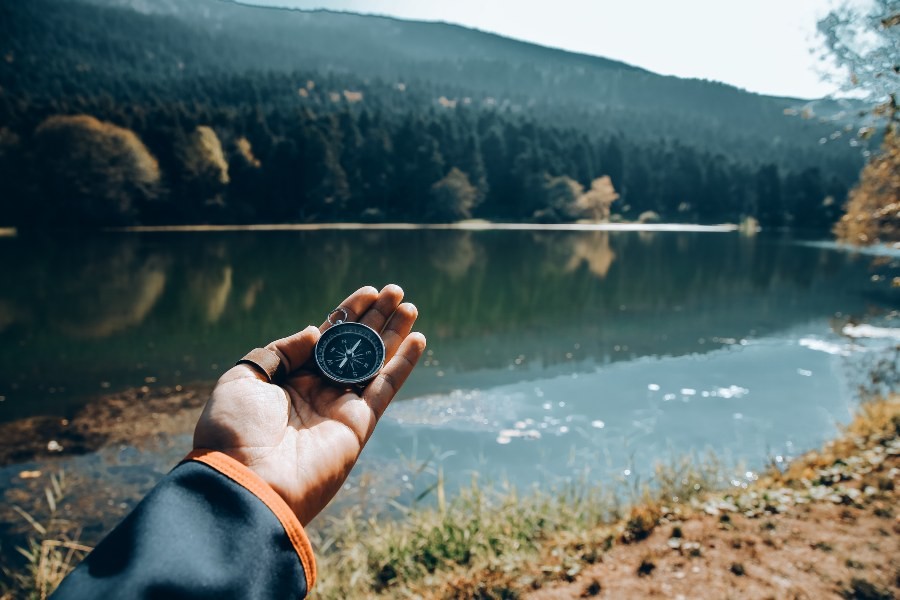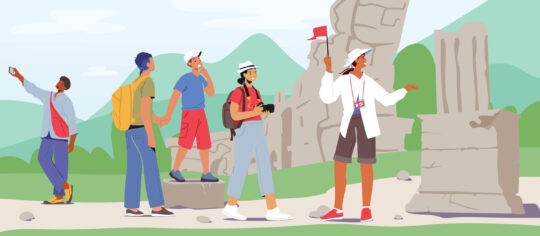Most tour and activity providers find themselves embracing a career in the travel industry through an appreciation for certain cultures or destinations. But to be successful in this role, you need to know which tour guide rules to keep in mind.
As a tour guide, you have a profound impact on how a guest interacts with their surroundings. And you also have the power to offer guests a life-changing experience through your charm and wit.
Sure, you don’t have to become the expert on the komodo dragon or shark mating rituals, but does it hurt to have a few fun facts at the ready?
Nope!
Ultimately, a skilled tour guide will know when to turn up the charm and dial the facts back to match the bandwidth of their audience. And as a tour guideline, you should adjust your performance based on the feedback and social cues you receive from your audience.
TL; DR: To be a fantastic tour guide, you should be full of enthusiasm, knowledge and kindness.

What are the golden rules of tour guiding
For many, guiding tours is an ideal way to see the world while getting paid to travel.
However, the role of a tour guide can be highly impactful, if you focus on making it fun and entertaining. Not only do you have endless opportunities to meet fascinating people from all over the globe, but you’ll never stop learning.
It makes sense that some of the best tour guides are hungry to connect with new people and enjoy reciting fun facts about what makes a place special. And whether you’re a pro or just starting out, it helps to know which tour guidelines to follow.
1. Be present, punctual and full of personality
There are few things worse than a tour guide who isn’t engaging, especially when guests arrive with high expectations. Show a vested interest in your guests during the first meeting — especially if you have a few early bird arrivals.
And since this role is equal parts education and entertainment, people with big personalities tend to do well as tour guides. This is a credit to having the ability to add a little extra zest to an experience.
Personalize the experience
The reason why people still book live tours is that in-person delivery is better than reading a guidebook. Ultimately, you have the power to transform an ordinary encounter into something more memorable. To do this, you’ll want to become a storyteller.
Do you know what’s worse than being a tour guide without a funny bone? Being hard to hear! If guests are straining to follow what you’re saying, they’ll likely tune you out.
And, even better if you can drum up fodder that travelers will not be able to find in a guidebook. Whether it’s because it’s new, insider knowledge or off-the-cuff — fun facts can send your guests into a fit of laughter and keep them engaged.
2. Know your stuff — as a tour guide rule
What do travelers often rave with tour guides? Approachability and good candour tend to show up in 5-star reviews, highlighting how a good attitude goes a long way.
You’ll need to stay up-to-date on the subject matter because guests are going to expect you to have all of the answers. With that said, you do not need to fib if you receive a curveball question. Instead, invite the audience to chime in if they have an answer or commit to finding out and responding at a later time.
Still, no matter how much you prepare, some travelers will throw some quizzical questions your way. Lean into your ability to charm and dazzle people with your local knowledge to escape these encounters unfazed.
Take time to prepare
Understandably, tour guides should have all of their ducks in a row once the tour starts. Dedicate time to doing a dry-run of your tours in advance to avoid potential hiccups that might pop up en route.
Typically, guides know where they are going, have a good sense of direction, anticipate when local restaurants and popular landmarks will be open and busy while also gauging optimal times for travel overall.
3. Engage with guests while sharing tour guidelines
Get to know your guests by striking up a conversation. There’s something known as the “third thing”. I learned about it from a brilliant architect friend who shared that wherever two people can find an item or topic they are familiar with, it helps to strike up a conversation.
In reviews, tour guides who are engaging and entertaining receive high praise. We know that becoming a 5-star tour guide takes work, but the added effort will pay off through reviews and word-of-mouth referrals.
Becoming a skilled communicator
Guests want a tour guide is confident and fun to be around. You’ll want to conduct the tour at a pace and tone that’s easy to follow. What does this sound like?
Use inclusive language to make guests feel welcome. The best way to brush up on your communication skills is to use them on a regular basis. Invite discussion and provide context for your guests to ask questions.
4. Offer helpful and timely insight
When leading a tour group, you’ll likely be commenting on things you’ve seen many times before. Imagine yourself in the shoes of a traveler.
So while you may find yourself constantly searching for new ways to talk about the same thing, it’s the first time for many — if not all — of your guests. When you share stories or recite unconventional facts, small details like these kick the experience up a notch.
Try changing up your route or focusing on different sensory receptors to offer fresh and fun ways of re-visiting the same places.
You want to create an inclusive guided experience that welcomes all types of travelers — including kids, visitors with mobility challenges and slower-paced adventurers.

5. Address guests and answer questions
Some travelers might initially be nervous to ask you questions because they will yet to have a rapport with you.
Think about common questions guests have and aim to proactively address them with your guests. And determine which facts you believe will be most advantageous for guests to know, then share them — openly.
To combat this, position yourself as a friendly and approachable guide who’s here to do just that — guide their experience. Reiterate how the tour is theirs alone, but your role is to facilitate the best experience possible.
Speak loud and proud
Annunciate. Broadcast. Project. This is not a time to use your library voice. I mean, there’s a balance, but aim to be vocal enough that passersby find themselves eavesdropping on what you’re sharing.
An added benefit is if your tour heads somewhere quiet, guests will be tuned in to your voice and more likely to lean in if you’ve been using inflection to command their attention.
Aim to be full of charisma
While hard to define — charisma is a core element of becoming a successful tour guide.
It can be summarized as one part charm, one part knowledge and one part wit with a dash of humour for good measure.
6. Demonstrate good time-management and organizational skills
Leading by example is one of the most effective ways of gaining the trust of your audience. Sure, you’ll probably contend with a few latecomers on tours — but don’t let this derail the entire group.
For visitors arriving at a new location, they tend to have a lot of questions. On your tour, aim to proactively answer them and allow space to respond to your curious followers.
To better frame the experience, give your tour a dry-run. Without the pressure of a tour group, you can see when certain dining spots, viewpoints or transportation routes will be busy, and adjust your plans to maximize the visitor experience.
7. Infuse storytelling as part of your tour guide rules
There are plenty of advantages to becoming a skilled storyteller. First, as travelers, we thrive on stories. They help to forge new neural pathways and turn ordinary encounters into something more relatable.
And second, while it can feel intimidating to share personal anecdotes and memories, storytelling elevates the tour for your guests. Plus, you can ad lib and you’ll have guests who are none the wiser.
Peter Syme shares something called the Peak Design Rule, where he suggests tour guides identify elements throughout your tour that is most helpful, entertaining and valuable, and design your tour around that.
Travelers develop a greater capacity to recount their adventures in a favourable light with personalized tours.
8. Keep things moving
When you step into the role of tour guide, you assume the responsibility of educator and entertainer.
There will be times when you have a restless audience member or guests that tune you out. Don’t panic — instead, aim to keep a consistent pace throughout your tour.
Account for buffer time throughout your route, giving consideration to guests of all ages and mobilities. And once a tour begins — keep that trust going by letting visitors know what to expect next and offering reasons behind each stop you have planned along the route.
9. Offer breaks
If you’re leading a scenic tour, note a few stopping points en route where guests can expect to have a few minutes to snap photos and take in the view. Allow ample time for breaks while on tour. They allow guests to feel refreshed and ready for the next stop on the tour.
In addition, short pauses help guests rest up, so they have the capacity to mentally digest more information.
Bring some snacks along
Instead of waiting until the eleventh hour to lead your guests to a dining location, bring snacks and water as a safety mechanism. This is especially useful for guests traveling with young children. And while it’s not expected, it can absolutely save the day for a family who just needs a little extra support.
Food can act as a bridge between cultures. You’ve probably heard the term “hangry” or been on the receiving end of a guest who’s coping with low blood sugar.
Ultimately, you’ll have some guests who are keen to see the next vantage point and a handful of tour guests that are more inclined to take their time meandering along the route.
10. Start and end tours on time
There will always be guests who misgauge timing or location and show up late to a tour. And while travelers might visit a location for the first time and find themselves running behind, this should not take away from your fellow guests who arrived on time.
One thing you should have control over is whether your tour or activity ends on time. Instill a walking pace that accounts for little ones and more mature travelers, by building in some buffer into your schedule.
This way you can feel good about pausing to talk more in depth throughout your tour.
Research proves people tend to remember negative experiences more readily than positive encounters. It could be that guests are hardwired to weigh bad encounters differently than positive ones, but it’s also a way of keeping them safe from repeating the same mistake in the future.
Helpful tour guide rules to keep in mind
Ideally, you want to create opportunities for guests to feel included and listened to throughout your tour. If it works for your style, ask questions in advance and help them to feel involved in the experience.
But, one thing to keep in mind is that your job isn’t done when the tour ends — you’ll want to bookend the tour for guests with options for learning more along with prompts for a review.
Remember:
- Guests don’t know what you know — overshare information to keep visitors in the loop
- Include a safety overview whether it’s related to gear, the location or the route
- Provide guidelines for what to expect and how they can expect to interact with you/others
- Let guests know where to find washrooms en route
- Build in buffer timing in case guests are late
As a general tour guide rule, the greater amount a guest pays, the more they will expect from the lead tour guide. You may find that tipping is activity and location-dependant.
But with guests visiting from all over the world, make sure you share how tips indicate that you’ve done a great job and while not required, are greatly appreciated.
Set a tone of curiosity, competency and confidence early on. This way, travelers arriving bright-eyed and bushy-tailed — will be ready to trust you to show them the world.
Want to become a top-notch tour guide?

Subscribe to the Checkfront Newsletter
Read new tips on how to get more bookings every month.



